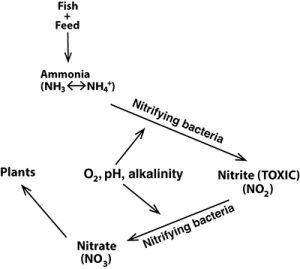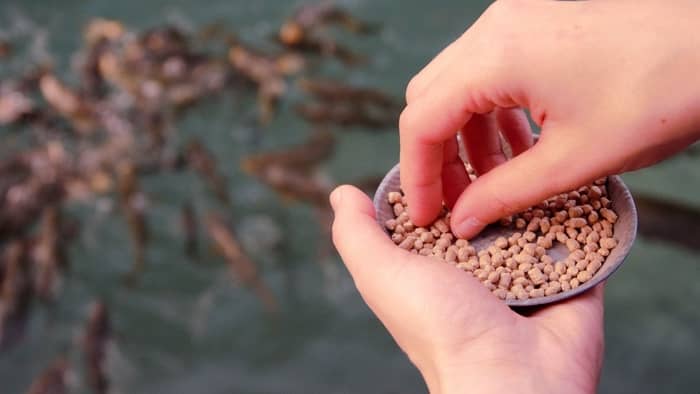Last Updated on September 8, 2024 by Sara Rose
Welcome to your simple guide on how to reduce Nitrites in your fish tank!
A key tip to keep your Aquaponics system thriving is to reduce your nitrite levels.
Nitrites and Ammonia are two forms of Nitrogen commonly found in Fish Tanks. The health of your whole aquaponics system is compromised when your Nitrite levels exceed a certain level.
Although it is naturally occurring, you have to be very careful to make sure that the levels do not get too high.
It is highly recommended that you understand water chemistry and how it works before you build your system. This will save you huge headaches in the future.
Follow this guide to learn the easiest ways to keep your tank healthy!
Table of Contents
Understanding Ammonia and Nitrite In A Fish Tank
Nitrites and Ammonia are byproducts of organic material breaking down inside the water. The source can come from fish excretion, plants in your system, or uneaten food particles. When these materials break down, the chemical composition changes.
At the beginning of decomposition, they turn into Ammonia which is very toxic for plants. Then, naturally occurring bacterias that live in the water turns the Ammonia into Nitrite.
Organic waste breaks down to follow the biological path listed below:
First, it becomes Ammonia, then its converted to Nitrites, and finally BACK to a usable form of Nitrates which actually helps your plants grow! Keep in mind, Nitrites AND ammonia are toxic to fish.

No matter what kind of system you have, this natural process will occur. However, if you do not take proper care, the ammonia levels in your fish tank can get out of control and have severe consequences for your fish!
How and Why To Lower Nitrites In A Fish Tank
Aquaponics is an art that you must commit to. If you don’t “tend your garden”, it will not survive.
When Nitrites get too high in your system it affects your fish in the following ways:
- Oxygen levels lower due to excess growth of plants such as algae
- Cell growth is slowed in your fish which results in weakened immune systems, reduced appetite, and low energy
- Increased spread of disease, often causing death
The best and most simple way to reduce nitrites in your fish tank is to keep your system CLEAN. If your tank gets too dirty without any filtration, the ecosystem will quickly become imbalanced and unsuitable for fish to live.
An easy way to keep your water clean? Replace the water on a weekly basis! Changing your water will continually give your tank a fresh start and remove any excess debris that has compiled over the week.
Measure the PH and temperature of the new water to avoid shocking the fish. You want the PH and temperature to most closely match the old water (unless there was a PH imbalance).
If you do not want to change ALL of the tank’s water, you can consider changing around 20% of the water each week. Pay attention to your tank, if the 20% water changes are not enough you will have to do a full water change.
That being said, if you are an environmentally junkie like me, you are concerned about the sustainability factor of this approach. Changing the water every week means the use of A LOT of water- which is a scarce resource in today’s changing earth. Also depending on the size of your tank, it can be quite time-consuming.
A simpler approach to avoid the build-up of these bacterias is to “turn off the supply tap”- meaning don’t add too much organic material into your system. Most specifically, avoid overfeeding your fish at all costs! Food that they don’t consume will decompose and become Ammonia and Nitrite.

Learn more about: What To Feed A Fish When Out Of Fish Food
Another important tip is to not overcrowd your tanks- check how many fish your tank size can handle. The more fish, the more excretion, thus the more organic material entering your system.
All About Filtration
Another approach to keep your water clean is to have a very good filtration system.
There are a few different ways using a filter keeps your ammonia and nitrate levels in check. I recommend taking a multi-faceted approach to ensure success from all angles. First let’s talk about filtration options.
You can go with a man-made one purchased from the store or a natural filter using microalgae to trap and store the bacteria until you discard it (it can be used as a great N fertilizer for your garden)! The College of Agricultural and Environmental Sciences, New Mexico State University states that “Biofilters help break down organic matter and provide more micronutrients in the water.”
This approach tackles the overall ecosystem balance of your system and not just focusing on a specific problem.
A manmade filter is also another option. As you pump and re-circulate your tank water, the filter will trap surplus organic debris lowering the amount that stays in the water. The filters will need to be replaced or cleaned when it is overloaded.
Attention To Details
You can purchase Nitrate and Ammonium level test kits if you want to get an accurate view of your water quality. Ideal conditions are keeping the levels to 15 ppm (parts per million) or below. But, according to New Mexico State University, the PH level of your water heavily determines the amount of Ammonia and Nitrate that your system can handle.
So be sure to pay attention to all details! Establishing a healthy and balanced Fish Tank ecosystem is always your best bet in keeping everything happy. Make sure to approach your Aquaponics from multiple angles.
Many people rush into starting their aquaponics setup without taking the time to ensure all cracks are sealed. Ammonia and Nitrite build-up will quickly ruin your system and kill precious fish lives. So it’s super important that you know techniques to reduce nitrites in your fish tank.
Please feel free to comment and ask questions to learn more!
